NOTE: The following post ran in September of 2012, but warrants reposting today. Happy tagging!
One of the most common questions we get at the Texas Butterfly Ranch is how the heck do you tag a Monarch butterfly?
It’s pretty straightforward, really. You’ll need a butterfly net, a clipboard or mini notebook and a writing utensil to record your findings. You’ll also need tags issued by Monarch Watch ($15 for 25 tags). I recommend a hat and camera, too.
Before you go, apply sunscreen or insect spray if you use them, then wash your hands thoroughly. Monarchs and other butterflies are more resilient than we think, however, Deet, Paba and other chemical contact with their scales, wings and bodies should be avoided. There’s no need to sterilize your hands or wear gloves. Just wash your hands.
When should you go tagging? We only tag monarchs in the fall. Check the Monarch Watch website for peak migration time in your area. I like late mornings after my second cup of coffee. By then, the butterflies have had a chance to warm up their bodies and are out flying and nectaring.
Remember, butterflies won’t fly if the temperature is less than 60 degrees, so late mornings and afternoons on sunny days are ideal. Right before sunset is good, too, especially when they’re migrating. In the Hill Country in October, masses of
Monarch butterflies will often drop from the sky around dusk and look for roosting spots—usually in protected tree limbs and often near water sources.
Ready for some tagging? Here’s how to do it.
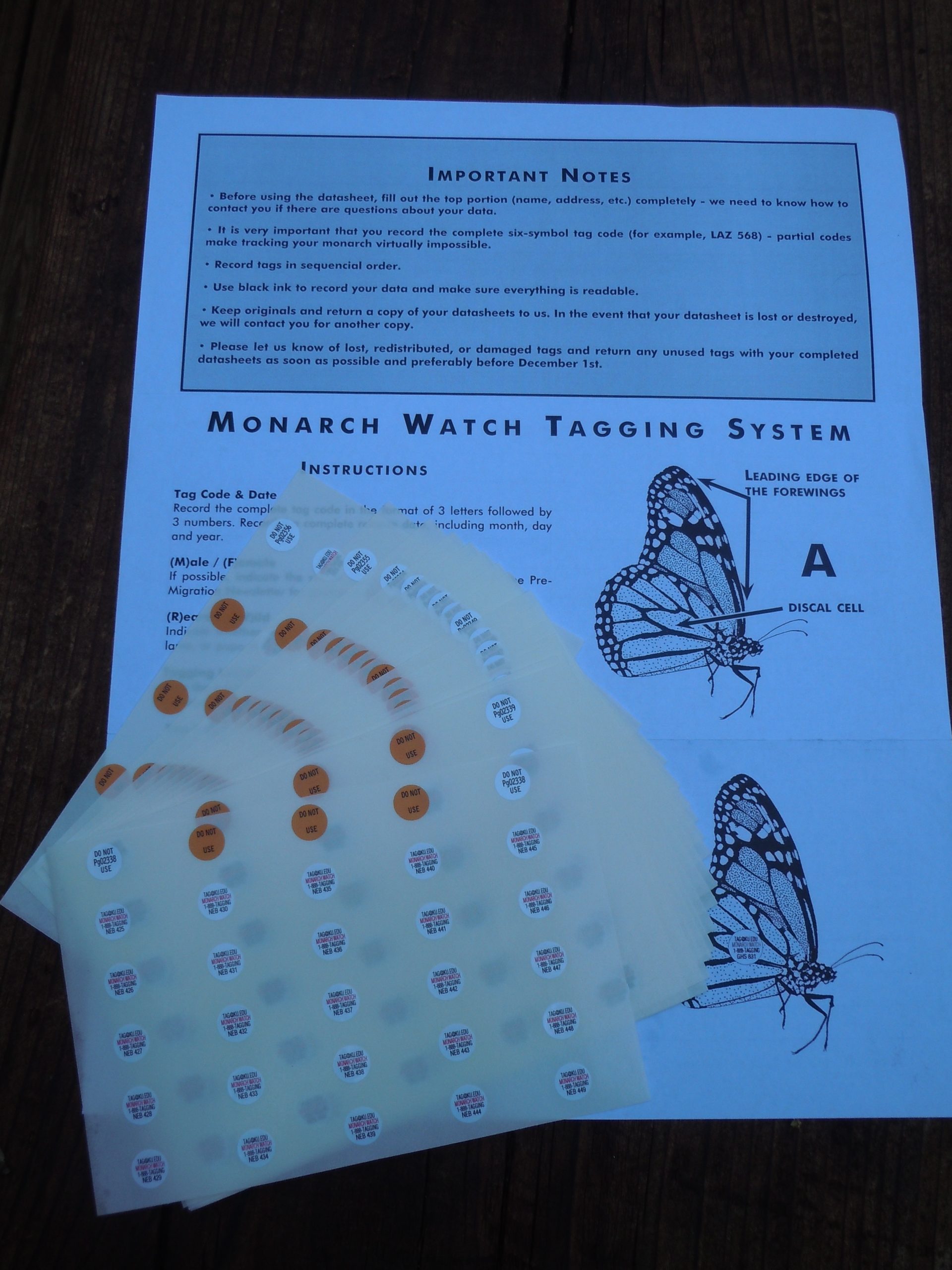
You’ll need Monarch Watch tags and data sheets to tag Monarch butterflies. And a butterfly net.
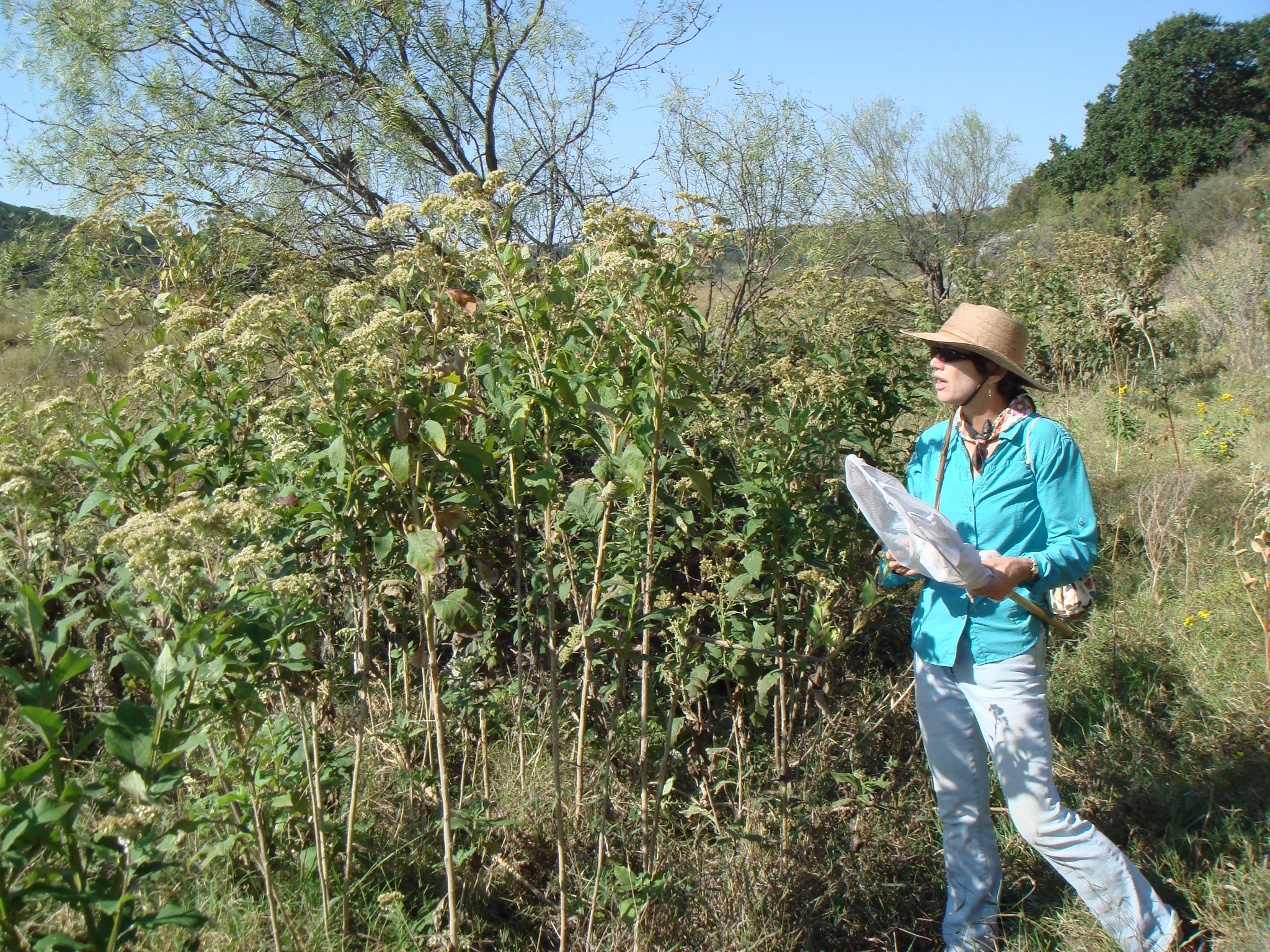
Frostweed is a fall favorite nectar source for Monarch butterflies. Photo by Monika Maeckle
1. Locate Butterfly
Millions of migrating Monarch butterflies will pass through the “Texas funnel” each fall. on their way to their ancestral roosts in Michoacan, Mexico, over the coming weeks and months. According to Monarch Watch, peak migration for San Antonio and Austin will be October 2 – 22.
Typically, we see a first pulse of vanguard Monarchs around Labor Day in the Hill Country and in our San Antonio and Austin gardens. In September we’ll consistently see individual Monarchs trickling through town. By October, groups will show up and form evening roosts in trees and large bushes like Poverty Weed along our rivers and other protected locations.
The best places to see them are along our streams and rivers where late season blooms offer a nectar rich rest stop. Monarchs fuel up on their journey south, so anywhere with late season butterfly-friendly flowers—native and Tropical milkweeds, Gregg’s Purple mistflower, Cowpen daisies, Frostweed, Goldenrod, lantana, for example—should draw them, as well as other butterflies.
Your own garden, if it has butterfly-friendly flowers blooming, should draw Monarch butterflies. Look, observe, wait. And be patient. For some prime Monarch butterfly spotting, stop by the Milkweed Patch along the Museum Reach of the San Antonio River this fall.
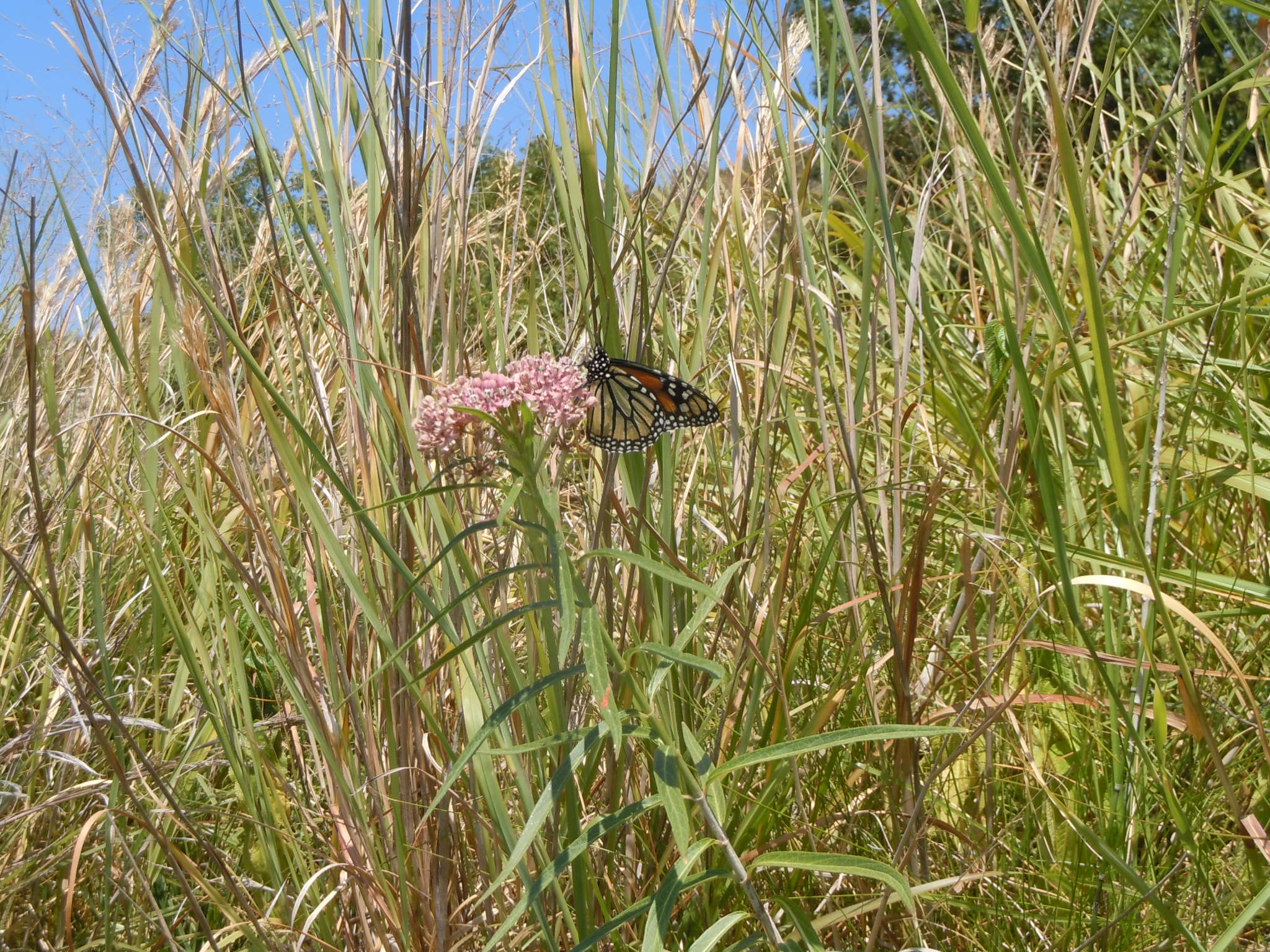
It’s easier to net Monarch butterflies when they’re nectaring. Sneak up on them from behind. Photo by Monika Maeckle
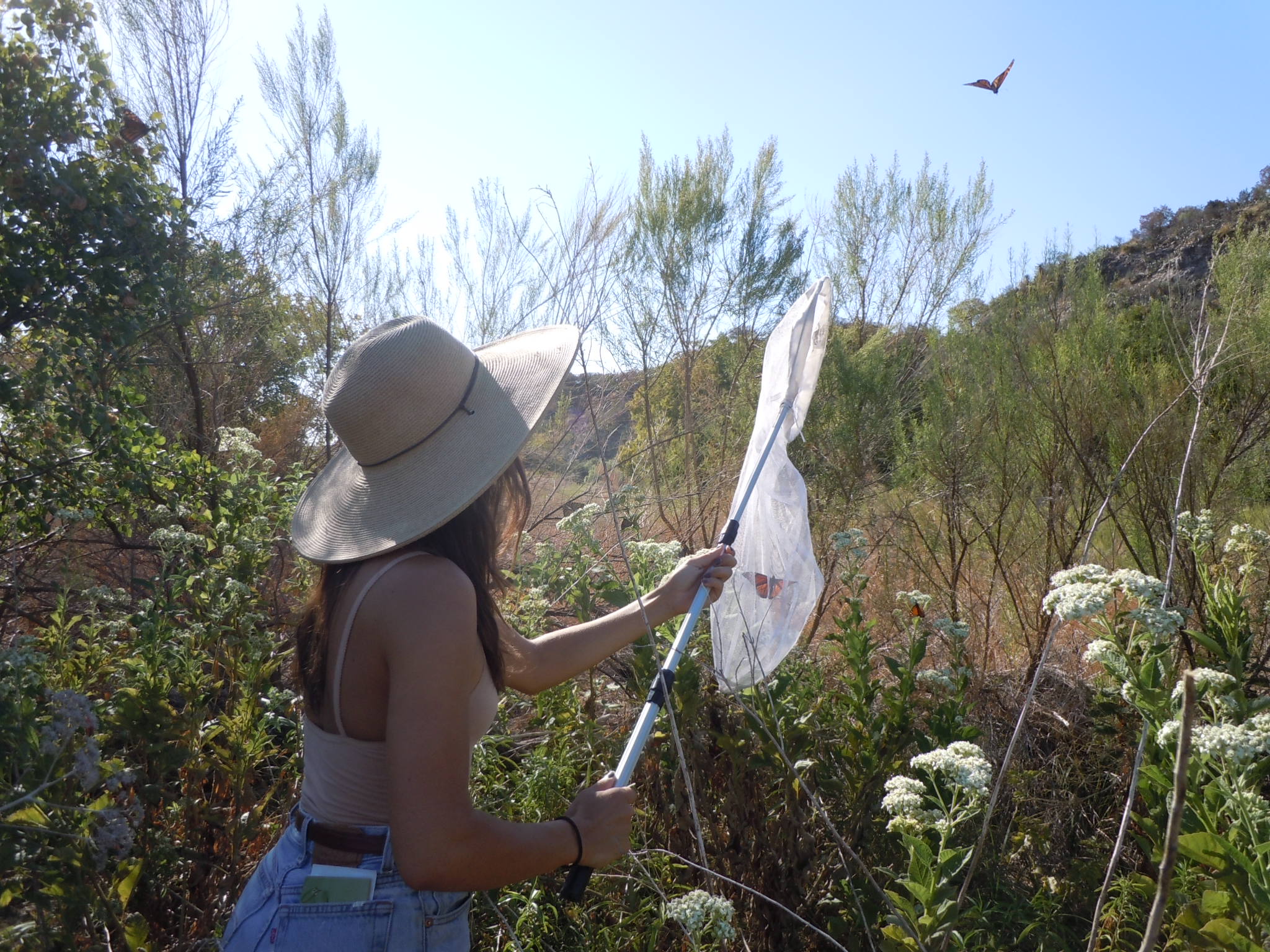
Annie Schenzel demonstrates proper net technique. See how the net sock is draped over the rim? No butterflies can escape. Photo by Monika Maeckle
2. Net Butterfly
Netting a Monarch butterfly—or any butterfly for that matter—is more challenging than it looks. The flitting creatures exhibit extreme skittishness and their compound eyes afford them a 360-degree field of vision. The slightest movement can send them sailing.
When I first started tagging Monarchs, I diligently chased them in flight. After slipping in the river more than once and skinning my knee after tripping down the steps at my house while in hot pursuit, I resolved to only try and net Monarchs when they’re roosting or nectaring. I’ve witnessed several ace netters with excellent hand-eye coordination, quick reflexes, and a sniper’s aim nab butterflies in flight, but I’m not among them.
Suggestions: wear low-key clothing that blends into the environment, move slowly, keep quiet and sneak up on them from behind. Once you swing your net, the butterflies will scatter. It resembles fishing in that sense; when you cast your line, the fish get spooked and flee, but they’ll be back. After a few minutes, the butterflies will resume their activities—nectaring, resting or roosting. Or they may fly out of your reach.
Once you get a butterfly in your net, be sure to flip the net sock over the circle of the rim—otherwise the clever insects can slip out. With the net sock folded over the net structure, they will remain in your net.
Some folks take the net down to the ground after they swoop the butterfly into the net to ensure the butterfly doesn’t escape. This is especially helpful when you capture many at once.
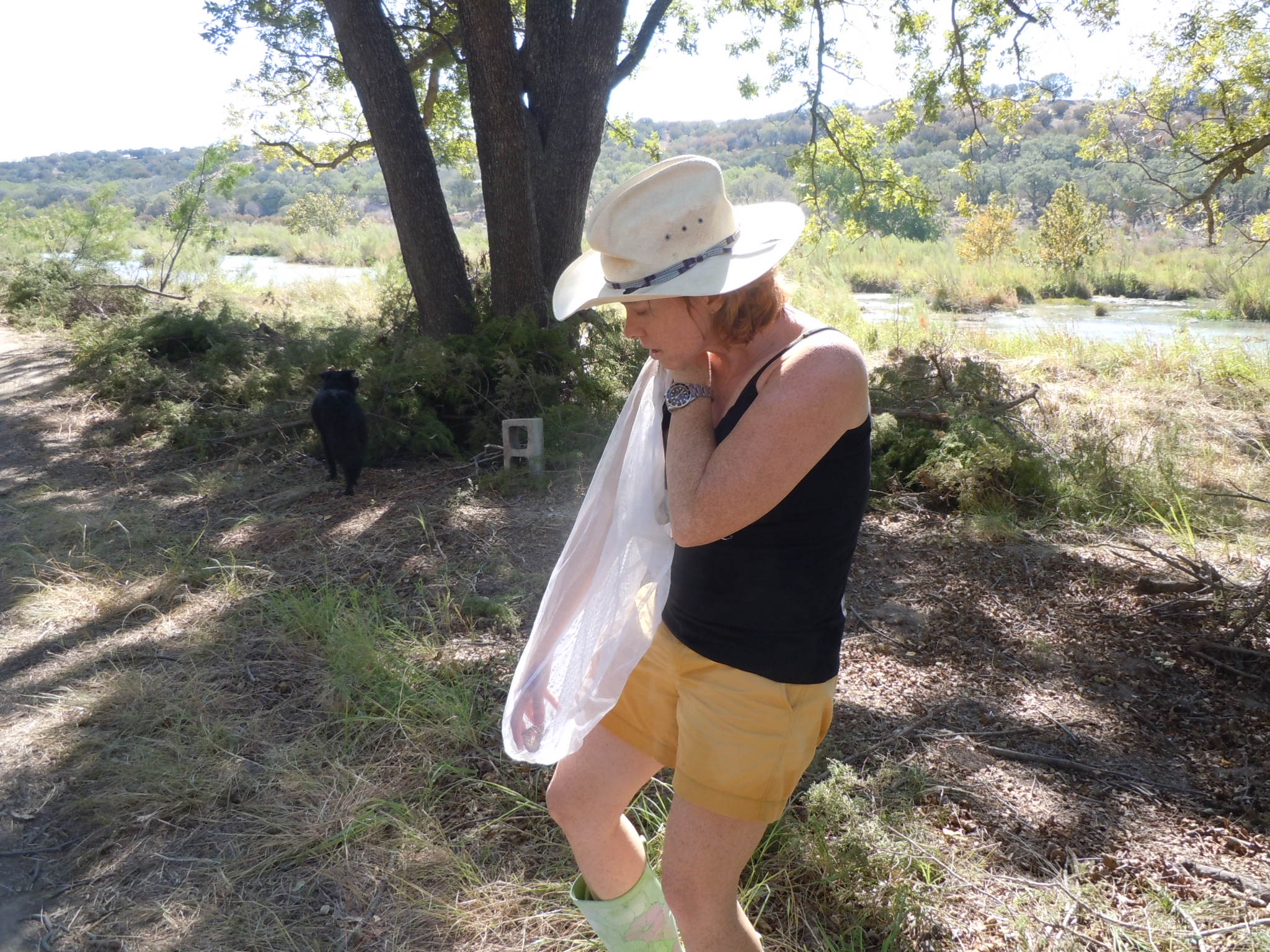
Tracy Hamilton shows how to retrieve a Monarch from the net. Photo by Monika Maeckle
3. Collect Butterfly from Net
Once the butterfly or butterflies are in the net, gently reach in and clasp an individual in your cupped hand, wings folded together if possible. (No insecticides or sunscreen on your hands, please.) The butterflies will flail around in the net, so try to calm them by folding their wings closed and gently pressing the net fabric on them. Also, try holding the butterfly upside down; it seems to calm them.
Keep the net closed so that other butterflies don’t fly out as you remove the one in your grasp, then pull out your catch and take a look.
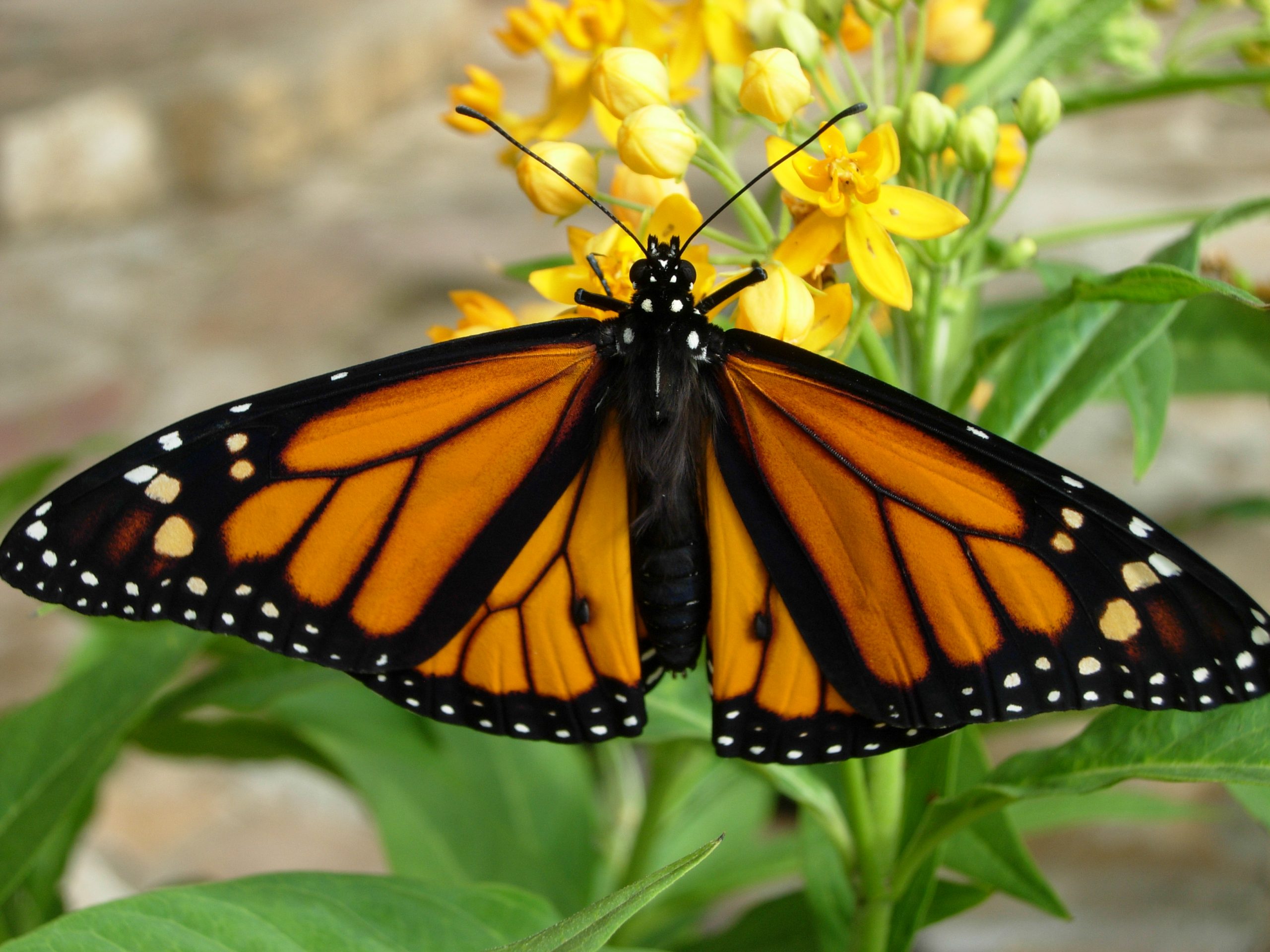
Male Monarch Butterfly: it’s a boy! See the two black dots on the veins of his lower wings? Those are pheromone sacks–supposedly they drive the lady butterflies CRAZY. Photo by Monika Maeckle
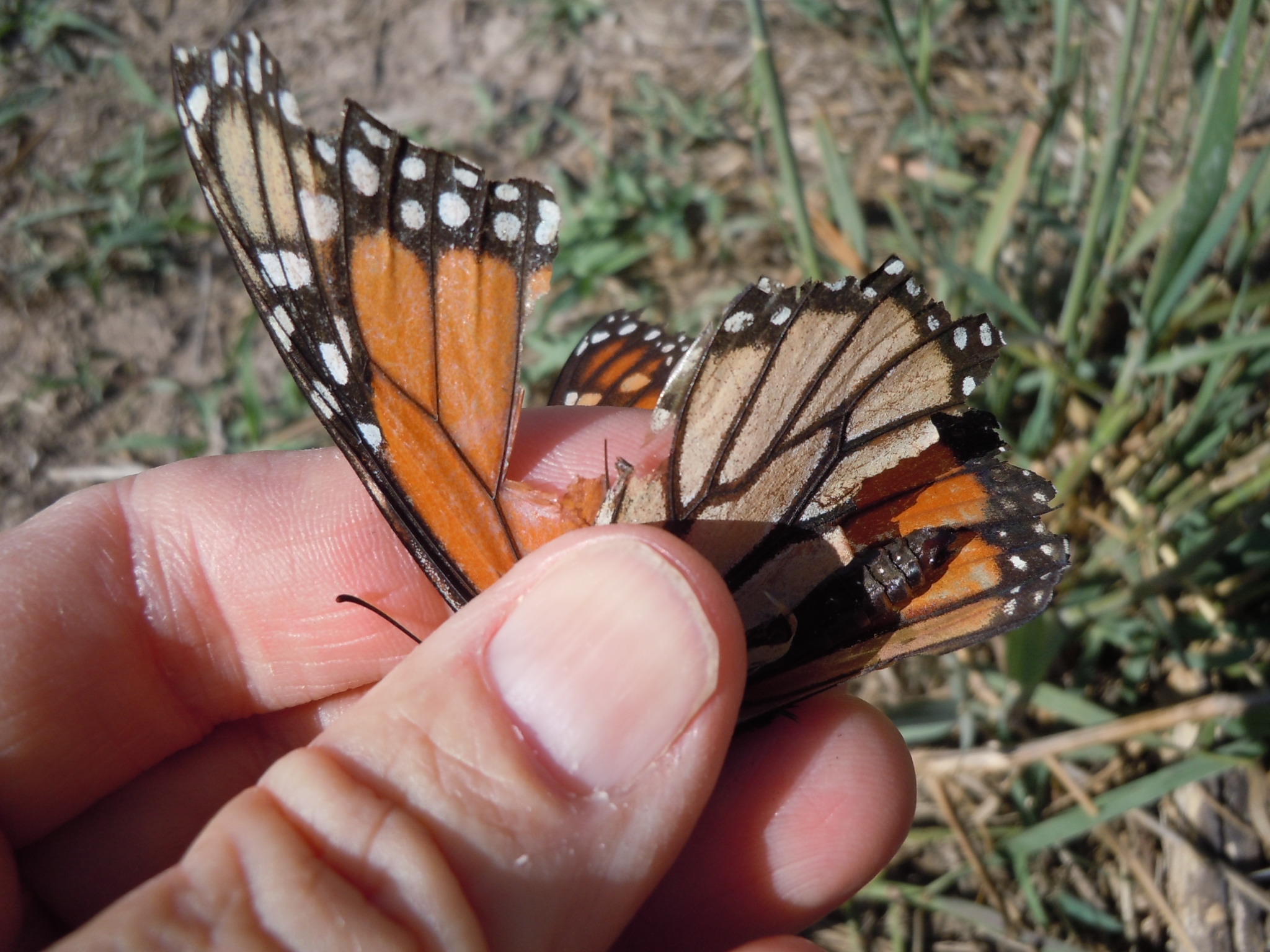
Raggedy Monarch butterfly. I don’t tag beat-up butterflies like this. Doubtful she’ll make it to Mexico. Plus, don’t want to waste tags. Photo by Monika Maeckle
4. Examine Butterfly, Establish its Sex
This is when you examine the butterfly to determine its sex. Open the wings gently and look for the two pheromone sacs on the lower half of the butterfly’s wings. If you see two black dots, it’s a male. If not, it’s a female. Also note the state of the butterfly—is it weathered and raggedy, or fresh and healthy? If the butterfly is extremely worn out and highly unlikely to make it to Mexico, refrain from tagging it. Let the poor creature fly off. Note the info on your data sheet or notebook, as well as the tag number.
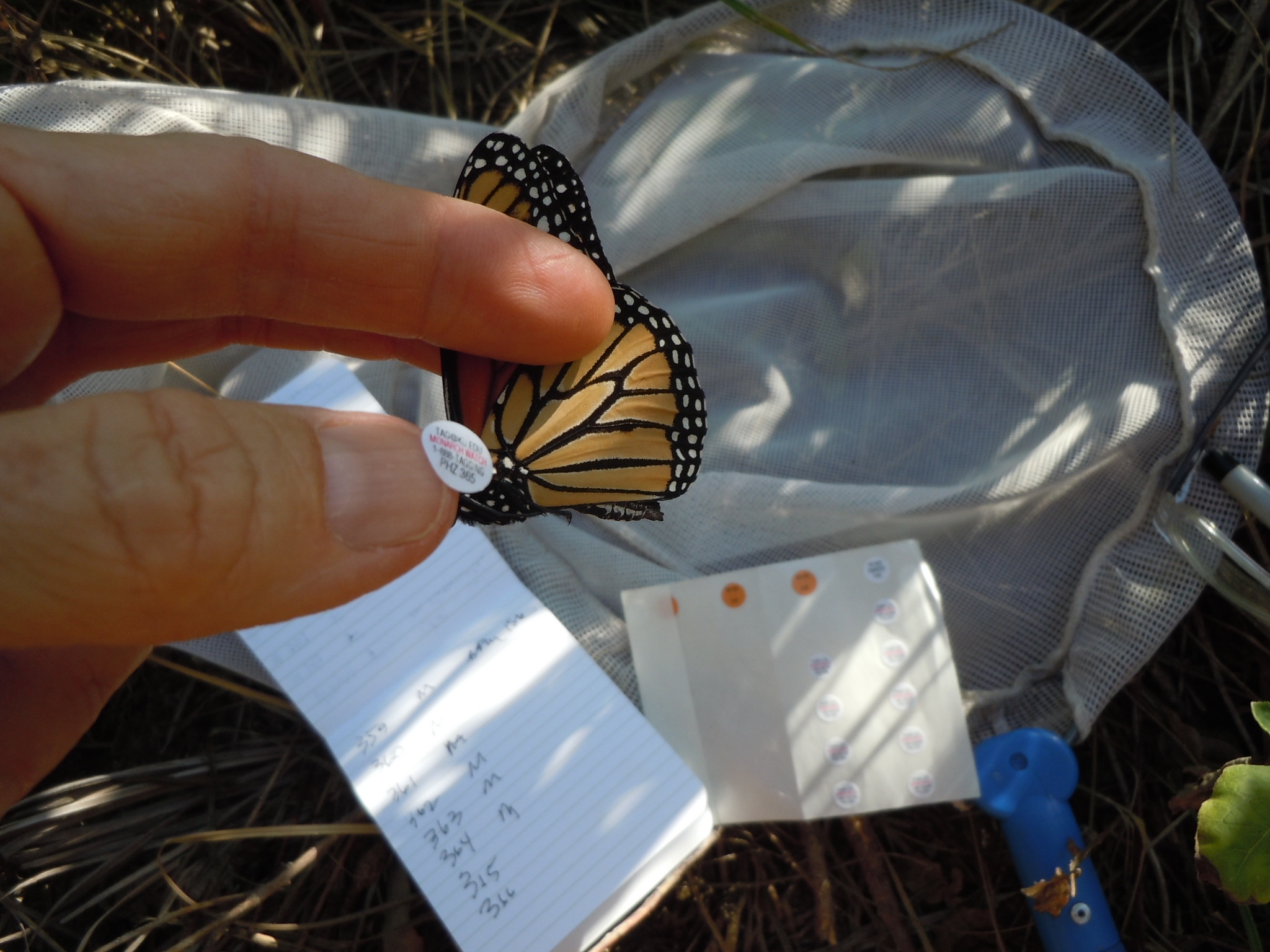
Use your thumbnail to lift tag from sheet and transfer to butterfly. Photo by Monika Maeckle
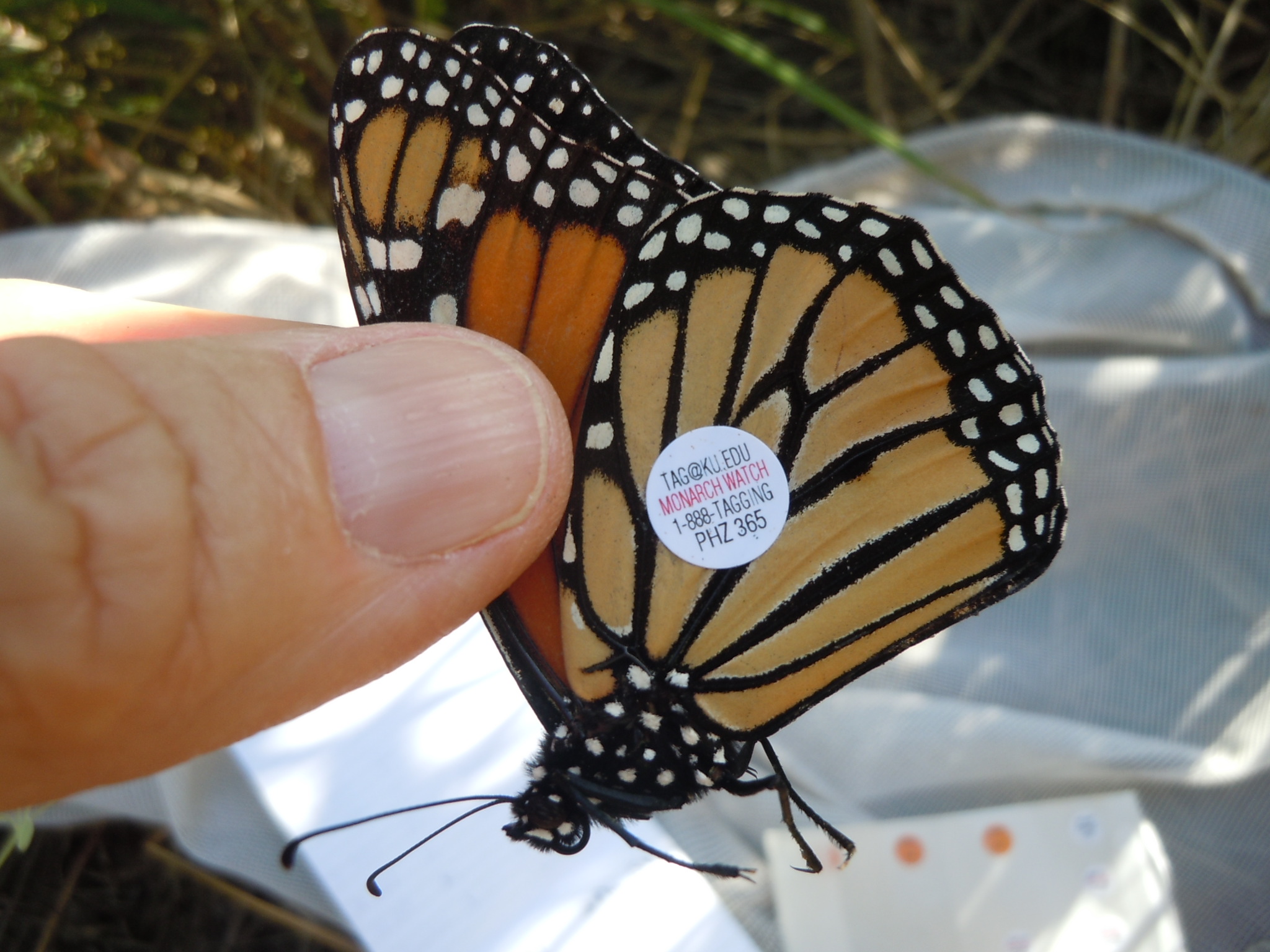
Press the tag onto the discal cell in the middle of the lower wing, as shown. Photo by Monika Maeckle
5. Remove Tag from Sheet and Adhere to Butterfly
Holding the butterfly between two fingers with wings closed with one hand, remove a Monarch Watch sticker from the tag sheet. I like to use my thumbnail and get them on the tip of my nail so they’re easy to slip onto the discal cell of the butterfly’s wing. Some people like to use a toothpick to lift the tag from the paper.
Place the tag on the discal cell, as illustrated in the tagging sheet sent to you by Monarch Watch. Press gently, but firmly. Congratulations! You’ve tagged a Monarch butterfly.
Make sure you’ve noted the tag number, butterfly’s sex, any other useful data, on your data sheet or notebook.
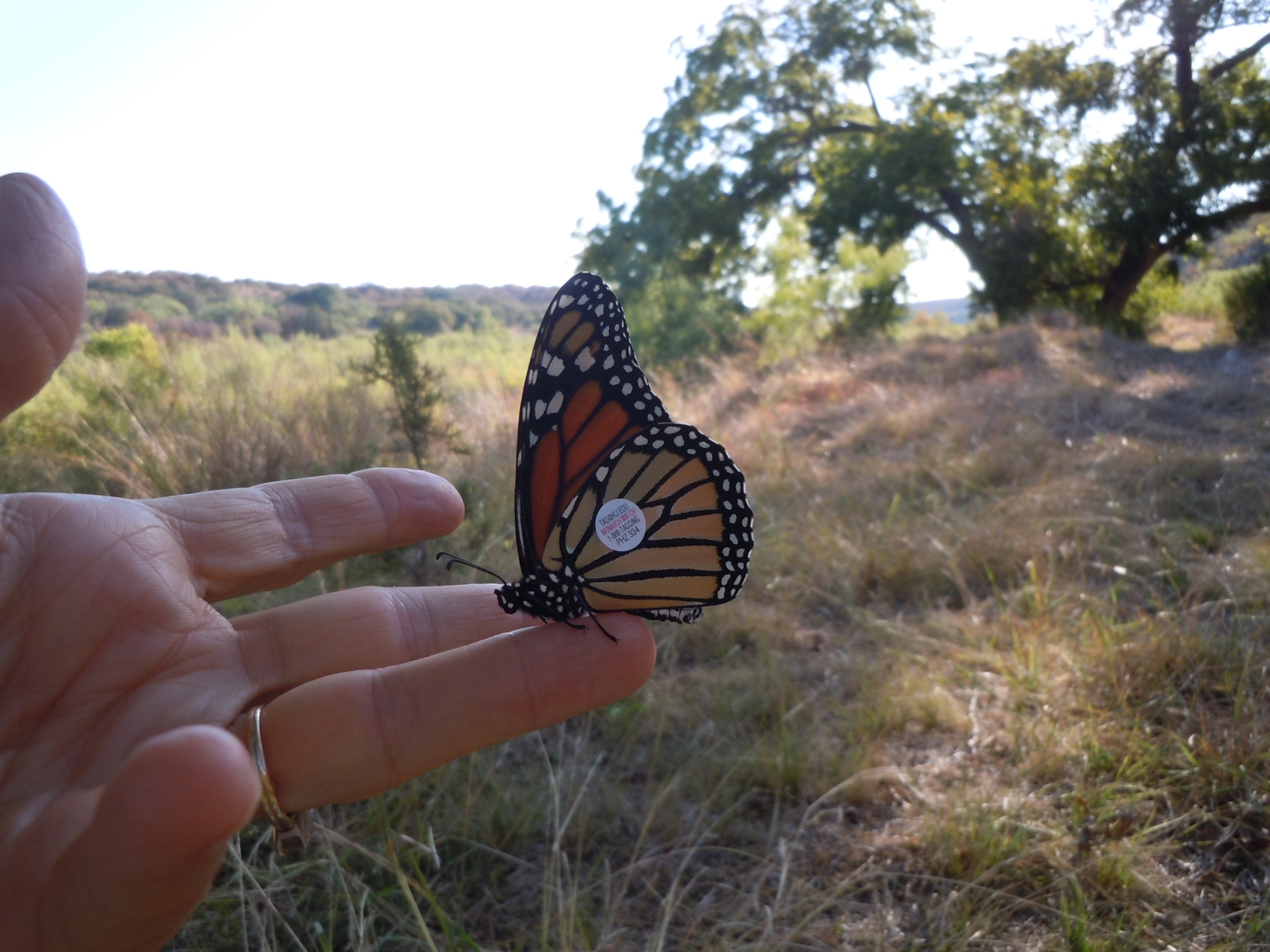
Off she goes! Photo by Monka Maeckle
6. Release
Open your grasp and let the butterfly go. If you’re so inclined, send her off with a kiss and best wishes for safe travels to Mexico.
After the Monarch migration season, send all your data to Monarch Watch by December 1 so it can be entered into the online tag recovery database. In the spring, you can check to see if any of your Monarchs were recovered in Mexico.
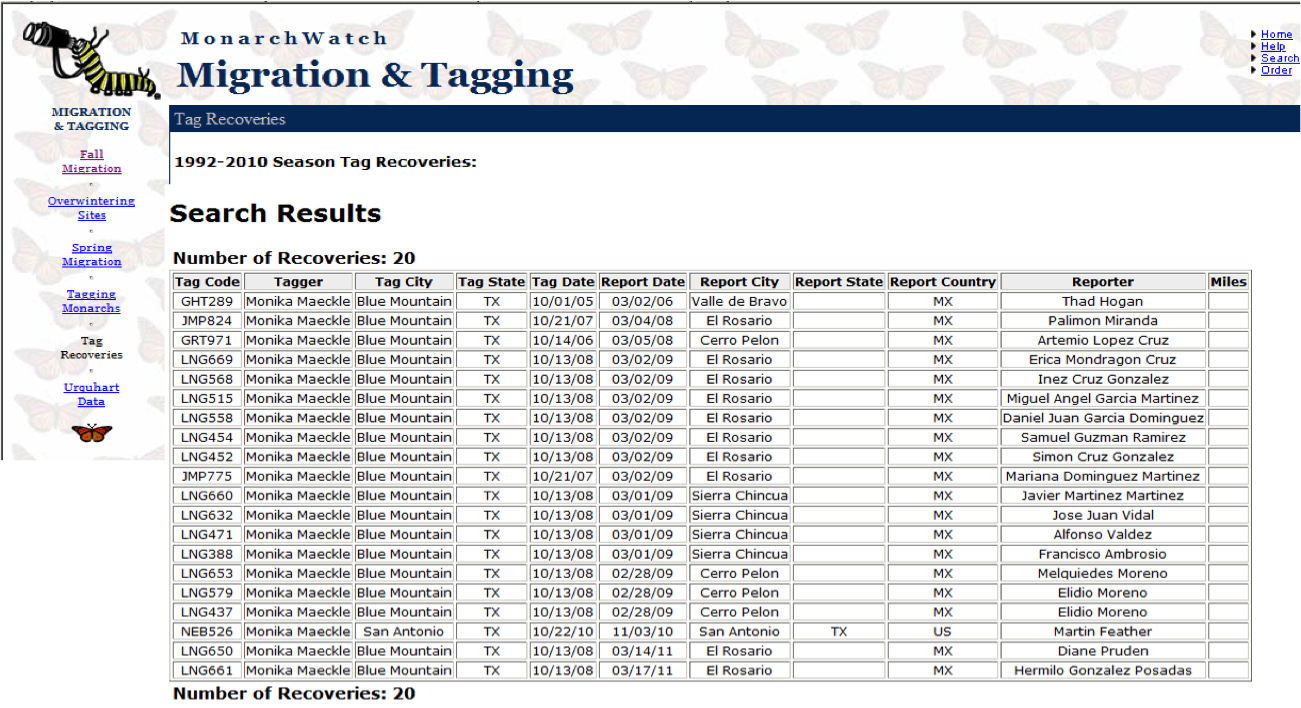
Of about 2400 Monarchs tagged, we’ve had 28 recoveries in Mexico. Photo by Monika Maeckle
Good luck with your tagging. Please let us know how it goes.
Related Posts
- How to move a Monarch butterfly chrysalis
- How to Raise Monarch Butterflies at Home, Part I
- Part II: More Tips on Raising Monarch Caterpillars and Butterflies at Home
- How to Raise Eastern Swallowtails at Home
- 2015 a banner year? Monarch butterflies heading our way
- Tropical Milkweed: To Plant it or Not is No Simple Question
- Oh Those Crazy Chrysalises: Caterpillars in Surprising Places
- Butterfly FAQ: Is it OK to Move a Chrysalis? Yes, and here’s how to do it
- Should You Bring in a Late Season Caterpillar into Your Home?
Like what you’re reading? Follow butterfly and native plant news at the Texas Butterfly Ranch. Sign up for email delivery in the righthand navigation bar of this page, like us on Facebook, or follow us on Twitter, @monikam.

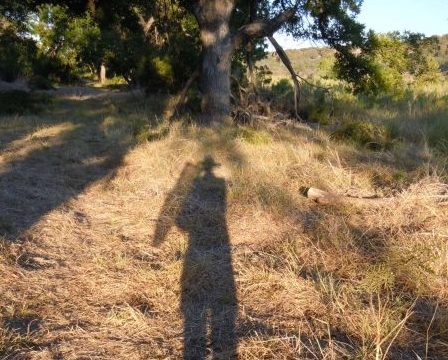
My husband and I raised and released over 980 monarchs here in Central Wisconsin this summer. We tagged 300 of them. Hopefully many of them will make it to Mexico and have a good winter there and hoping that the monarchs have an even stronger comeback next summer!
My first time tagging monarchs. I had 5 caterpillars, out of 5 , 1 has wing issues ..didn’t tag it. 1 didn’t hatch out, dried up. I did get 3 tagged and ready for release when weather is clear ( raining, hurricane / tropical storm watch this week). Worried they have not eaten or drank anything since hatch out day, I have banana, oranges and watermelon. How long can they go just in rest stages without eating? I have them in a dark room so they flutter around getting hurt wings. Hoping Monday for release if storm clears. ( 10/2/15 ) hatched (9/30/15).